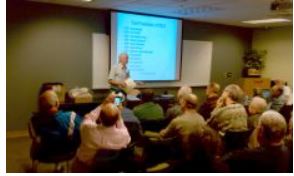Speaker Do’s and Don’ts
By Don Arrowsmith, Advisor, Region 3.
Working as an electronic engineer, I was very familiar with Murphy’s Law: Anything that can go wrong,  will. That seems to be especially true when dealing with program presentations. Like having a backup of your hard drive helps rescue you from a computer problem, it helps to plan for disaster when you have a room full of members expecting a pleasant talk from your speaker and a problem develops. I will describe several techniques I’ve depended on in three scenarios: live speaker, remote speaker, and video presentation.
will. That seems to be especially true when dealing with program presentations. Like having a backup of your hard drive helps rescue you from a computer problem, it helps to plan for disaster when you have a room full of members expecting a pleasant talk from your speaker and a problem develops. I will describe several techniques I’ve depended on in three scenarios: live speaker, remote speaker, and video presentation.
Live Speaker
- Of course, you contacted the speaker months ahead to get you r group on their schedule. I suggest you ping them a month or so ahead plus a week or so also just to make sure they haven’t double booked or had something come up in their private life.
- It’s also important to make clear what the technical requirements are: If they show up with an iPad and you have only a ceiling mounted projector with a VGA cable, you have a problem. You might want to invest in some adapters for your system that would accommodate a range of equipment: Apple TV; standard, mini and micro HDMI to VGA; etc. Be sure to test the whole setup ahead of time.
- Audio is usually less of a problem but with a projected loss of headphone jacks, adapters will become necessary.
- Even with GPS devices, I suggest sending the speaker a link to an online map; a pdf of a printed map; written directions; and GPS coordinates if they have never visited your site before.
- The exact time, including time zone and DST state, plus how much ahead of time you would like them to show up should be listed.
- I always provide a cell phone number and request a cell phone number to use before panic takes over.
- Request that the speaker bring a second copy of his slides or other files on a flash drive. That way, if his laptop dies or is incompatible, another laptop could be used. I also, try to persuade the speaker to allow me to post any slides at our web site to make his information available to members who might have missed the event. Having a set of files on a flash drive already there might make that more likely to happen.
- Try to have a backup laptop and other gear available. I bring a spare projector but keep it in my car trunk. We have had a bulb burnout in the facility’s unit during a meeting and having a spare was a lifesaver.
- In case the speaker somehow never shows up, I try to have a spare presentation available: It’s easy to bring along a video on a flash drive. Even better would be a video on a topic similar to the announced one.
Remote Speaker
- Many of the above also apply to using a remote speaker: reminders, contact numbers, backup files, spare presentation, etc. Timing is very important when a time zone difference may be a factor.
- Network glitches can happen at any time. Try arranging for a member to bring a hot spot or a tetherable cell phone to use in a pinch. Of course, that won’t help if the speaker’s connection has trouble or if the Internet ‘breaks’. I have been in that situation and projected a backup slide set I received ahead of time while patching a cell phone’s audio into the room speakers, having called the speaker via the cell phone.
Video Presentation
- This should be the most trouble-free situation. I don’t depend on accessing the video over a network. Rather, I’ll only show a video that I can download beforehand and bring as a file (with a backup second copy on a flash drive). There are various online sites that will capture and provide a file from YouTube, Vimeo, and other video sites. For an overview of downloading options, see this PCMag.com article “How to Download YouTube Videos” from June 17, 2016.
- I primarily use a standalone program, YouTube Downloader HD to produce a file. Note that there are several similar sounding programs but some of them may be sketchy. And always use care that you don’t get any unwanted programs installed along with the one you want. This one has worked fine for me whether I’m using a YouTube video from our APCUG channel or another video. I email the original video URL to my members following the meeting so they can see it if they missed it or if they wish to see it again. For copyright reasons, you shouldn’t forward or post the video file.
